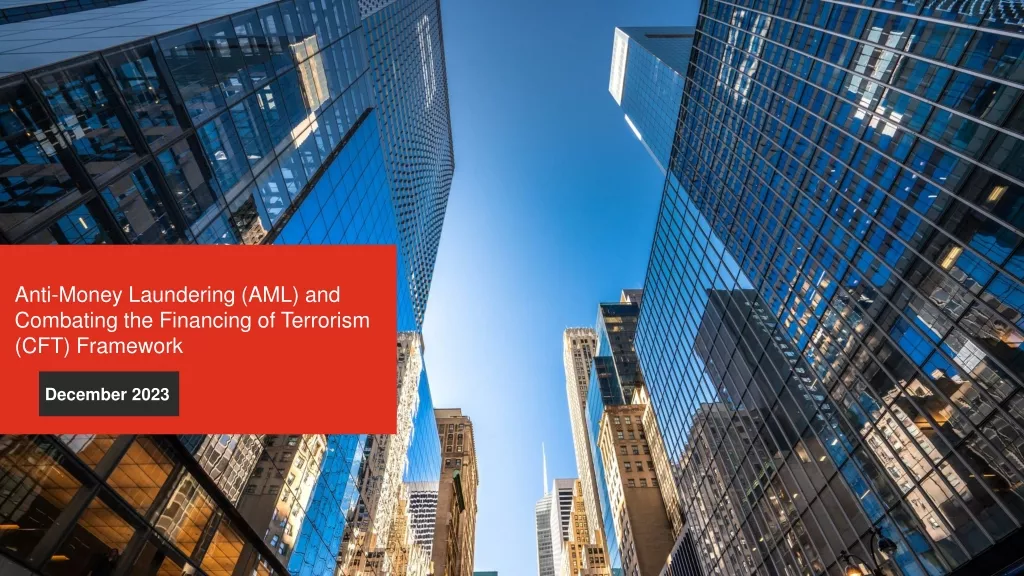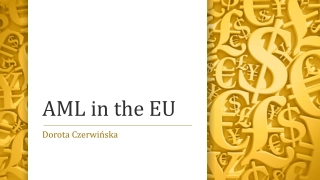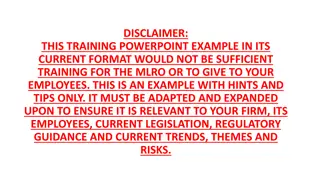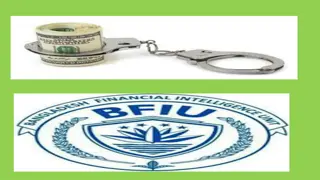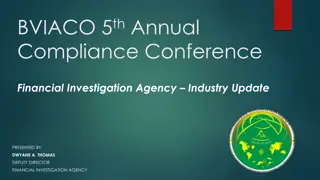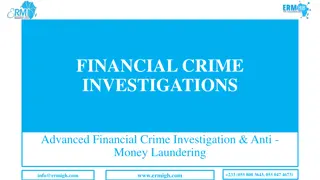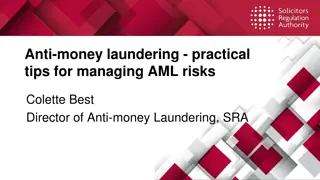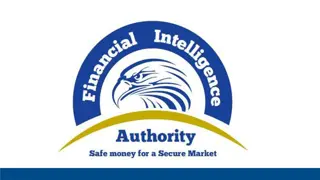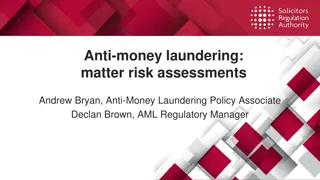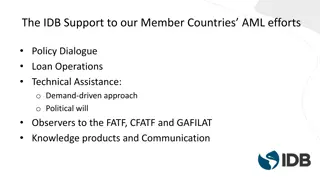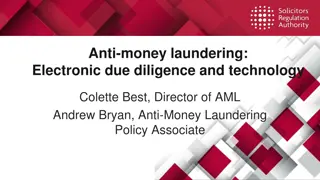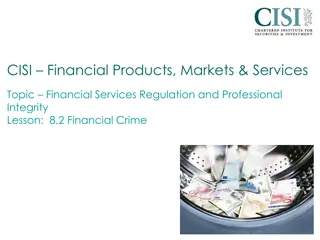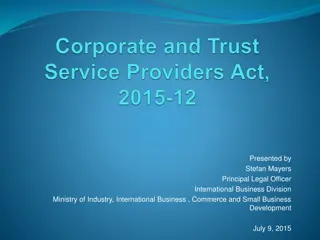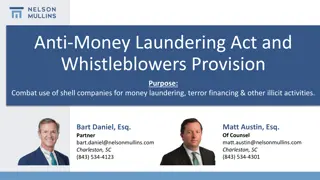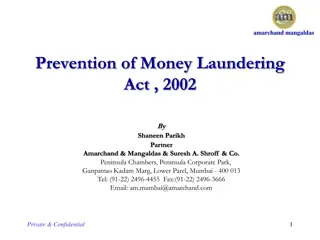A Practical Guide for Anti-Money Laundering Policies & Procedures
This comprehensive guide provides essential information on developing effective policies and procedures for anti-money laundering (AML) compliance. Covering topics such as risk assessment, customer due diligence, reporting suspicious activities, and integrating AML controls into daily transactions, it emphasizes the key roles of senior management and the Money Laundering Reporting Officer (MLRO) in ensuring regulatory compliance and risk mitigation.
Download Presentation

Please find below an Image/Link to download the presentation.
The content on the website is provided AS IS for your information and personal use only. It may not be sold, licensed, or shared on other websites without obtaining consent from the author. Download presentation by click this link. If you encounter any issues during the download, it is possible that the publisher has removed the file from their server.
E N D
Presentation Transcript
A Practical Guide for Firms Developing Policies & Procedures Graham Mackenzie Updated June 2017
ANTI-MONEY LAUNDERING Contents Slide The position of your P&P in the hierarchy of AML authorities 4 A Practical Guide for Firms: What written P&Ps are firms required to have in place? 5 Detailed Controls and Procedures Senior Management and MLRO responsibilities Risk Based Assessment Further information to assist members to comply with their AML duties, responsibilities & obligations Customer Due Diligence Suspicious Activity Reporting & Police Orders Quality Assurance AML Training & Record Keeping 6 7 8 9 9 10 How to ensure your P&Ps are integrated into every transaction 11 Summary 12 3
The position of your P&P in the hierarchy of AML authorities FATF recommendations feed into EU 4th Directive UK Primary Legislation & Case Law [MLRs 2017, POCA etc.] UK-wide AML Practice Note (Approved by HMT) Policies & Procedures (How your firm controls AML Risk) LSS Best Practice (via web site, articles & events) Risk & Compliance paperwork (recording implementation of your policies and Procedures) 4
What written AML P&P are firms required to have in place? Policy Statement: High level policy statement of intent/call to action Make available to external agencies (LSS, Police, Clients) Include firm s risk profile and outline of plan to meet threats Stated Commitment of Management Board and Managers Everyone in firm required to comply and has role to play Consequences of non-compliance - disciplinary/offence Detailed AML procedures: Reg. 19 of 2017 Regulations specifies what must be covered may be useful to structure your procedures around this Management Board set policy implemented through (internal) procedures Senior Manager/Board Director ultimately responsible for controls and procedures (Reg 21a) Useable in day to day activity set outs detailed procedures which are used in the firm Detailed AML procedures: 5
Sections/Content within Detailed Controls and Procedures Management Board (Senior Management): Responsible for designing and implementing controls to manage and mitigate the AML/CTF risks faced by their firm Appoint, resource and support MLRO MB commitment key Risk based approach aimed at identifying suspicious activity MLRO: Empowered, resourced, senior, AML & commercially aware Ultimately responsible for day to day management/control of AML within the firm. Duties include: Ultimately decide when a Client/Matter if client to be taken on where there is a high risk of money laundering Review SARs made from employees - decide when to submit to NCA Deal with any contact to or from LSS or Police Ensure all staff trained to level appropriate to their role 6
Sections/Content within Detailed Controls and Procedures Risk-Based Assessment Procedures should include how and when in the process the firm identifies client and transactional risk: Client Risk Know Your Customer Individual Transaction Risk Know Your Customer s Business When? Start: assess client AML risk at the start of the relationship and Transaction Risk when instructed on a particular piece of business Middle: re-assess (if appropriate) through the course of the deal has anything changed? End: Finalise the risk assessment just before the deal is sealed and cash changes hands Should list potential red flag indicators, risk factors & questions to ask during the risk assessment process Should control what happens when red flags/risks are identified Should state examples/type of evidence which should be held 7
Sections/Content within Detailed Controls and Procedures Customer Due Diligence Risk Level of Due Diligence Low Simplified/Standard Medium Standard High Enhanced Procedures should detail: Processes re. identifying and verifying clients Acceptable documents, data or information to be obtained Level of due diligence based on risk profile see table above What each level of due diligence means in practice Timing of CDD completed before take on business Responsibilities of Gatekeepers , Fee Earners, Partners, MLRO On-going monitoring procedures Demonstrates to LSS that adequate AML controls are in place 8
Sections/Content within Detailed Controls and Procedures Suspicious Activity Reporting (internal and external) & Police Orders Procedures should: Encourage & detail how staff should make reports to the MLRO Make it clear obligations under POCA are mandatory criminal offences Detail tipping off issues What should be included in reports Timing of reports What process should be followed in the event of a Police Order being served Quality Assurance: Procedures should detail how, and to what frequency the firm undertakes quality checking of compliance/AML files Procedures should detail how, and to what frequency the firm undertakes quality checking of compliance/AML files Procedures should detail how, and to what frequency the firm undertakes quality checking of compliance/AML files 9
Detailed Controls and Procedures Sections/Content within AML Training Requirements (Reg. 19 ciii & 24) Procedures should detail: Which staff require what training (specific to role) What form the training will take How often training should take place How staff will be kept up-to-date with emerging risk factors/new developments for the firm Record Keeping Requirements (R.40) Procedures should detail: How the firm manages, records and stores AML related material, incl. retention period Relevant records could be: AML Policies, Procedures, Manuals Risk Assessments CDD Evidence Evidence of staff training Suspicious Activity Reports E-Verification records PEP/Sanction Screening Searches 10
How to ensure your P&Ps are integrated into your firms day to daybusiness Firms do need to keep adequate records of AML/CDD material a list of relevant records is on the slide, and should be kept for a minimum of 5 years after the relationship has ended or the transaction has been concluded. Top Down Commitment Robust, written P&Ps promote clarity, certainty and uniformity Disciplinary/criminal law consequences underlines importance of getting it right Weave into standard working processes e.g. when on-boarding Terms of Engagement Covering Letter Client Questionnaire Source of Funds and LBTT form (purchase only) Becomes part of Pre-Completion preparation Use checklists/FAQs documents make it easy for staff to implement Include in Team Meetings, files reviews and annual appraisals Training and other AML activity serves to keep AML to the fore 11
To Summarise!! High Level Formal Policy (may be made available externally) Externally available high level policy statement of intent Senior Management/MLRO Responsibilities Risk-Based Assessment Customer Due Diligence Suspicious Activity Reporting (internal and external) & Police Orders Quality Assurance AML Training Requirements Record Keeping Requirements (R.40) Detailed Procedures (internal documents) AML Working Documents (Checklists/Records/Risk Assessments) How to ensure your P&Ps are integrated into your firms day to day business 12
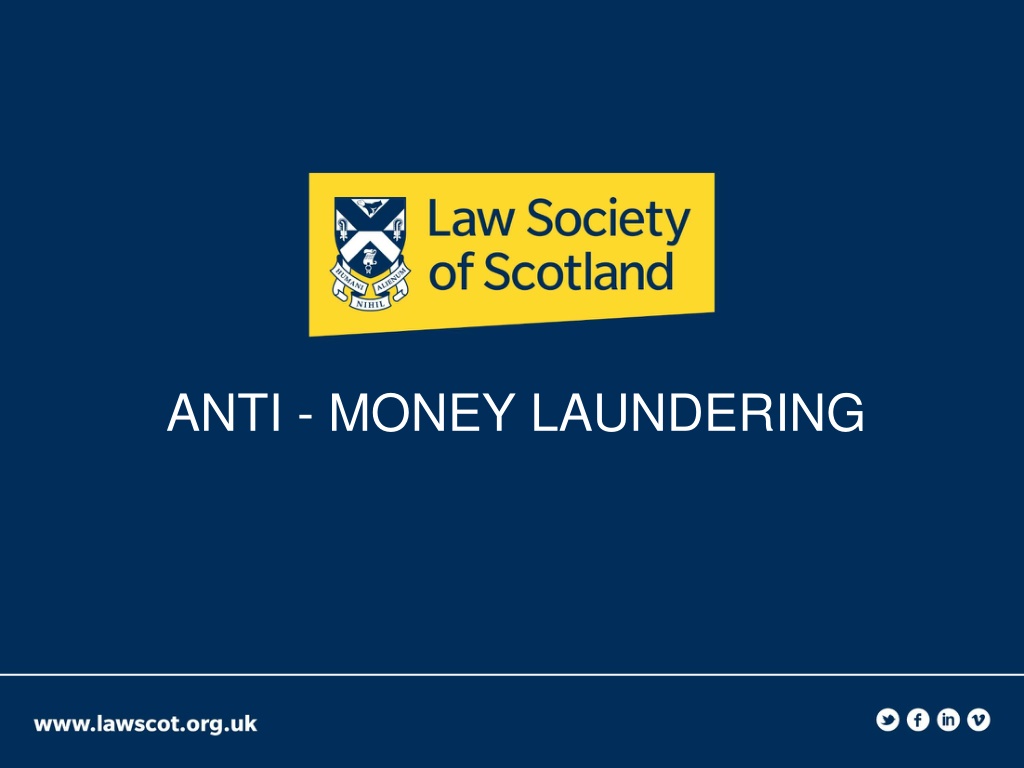
 undefined
undefined

